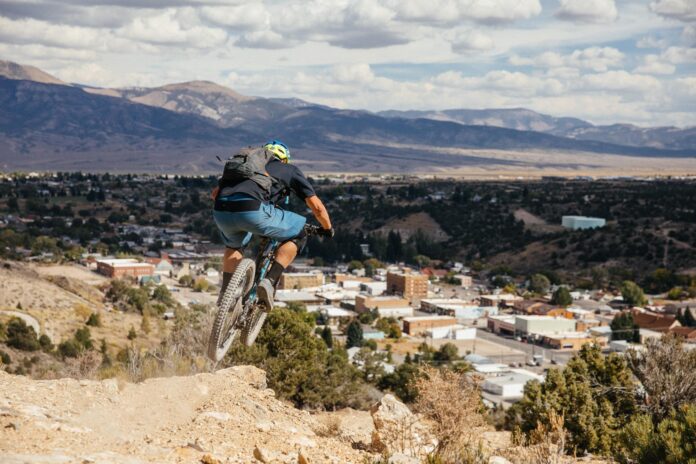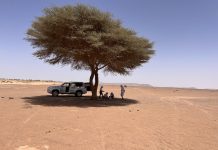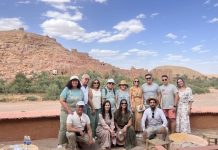Photo courtesy of White Pine County Tourism
When Singletracks published its newest list of the best mountain bike destinations around the U.S., there were few surprises. Moab still takes the cake, at least among those who voted, and other spots like Sedona, Bentonville, Crested butte, and Lake Tahoe have been riding high on mountain bikers’ bucket lists for some time too. It seems with time, most have aged well, but they have their drawbacks; oversold marketing campaigns, crowds, or expensive lodging.
We have the privilege of covering new trails and seeing new destinations grow on a daily basis and wanted to highlight a few spots across the country worthy of a mountain bike-focused visit that are growing and may be new to readers. Unlike the best MTB destinations list, where reader nominations played a large role, these three destinations were chosen by us. They reflect cities and towns with a strong or growing number of quality trails and a strong community surrounding them.
For now, these destinations are flying under the radar, even though they might not be that far under.
Ely, Nevada: a high desert trail oasis

Where exactly is Ely, Nevada? We’re glad you asked. Paint a picture in your mind if you will: five hours east of Reno, four hours north of Las Vegas, and three-and-a-half hours southwest of Salt Lake City. Yes, some might call that the middle of nowhere.
Like many great mountain bike destinations, Ely has a history as a mining town. Ely was founded in the late 1800s as a stagecoach stop and trading post before it became a huge copper mining region. It was also a stop on early railroad routes like the Pony Express, and the first transcontinental highway went through Ely.
Mining slowed after a major mine closed in 1999 and the community was hit hard, says Kyle Horvath, White Pine County Director of Tourism. Now, the mountain town of Ely is focused on building outdoor recreation for everyone, but especially for mountain bikers.
“The thing that keeps people here is the outdoor recreation,” said Horvath. “Other than us not having a Lake Tahoe, I feel like we’ve probably got the most diverse and highest quality outdoor recreation in the whole state.”
The trails
Ely is home to the Fears, Tears, and Beers enduro race, which is said to be the earliest enduro in the country, inspired by motocross enduro events in Ely. The town has an interscholastic mountain bike programs at its schools, and a committed advocacy organization, the Great Basin Trails Alliance (GBTA). The GBTA is volunteer run but has received generous grants from federal agencies to bolster the trails in the area.
They have a NICA team and scholastic MTB, and many things for visitors, but they want to develop the area for future or returning residents. The town lost about 2,000 people in 1999 when the mine closed, and they’d love to bring 2,000 people back. The goal is to lure families, retirees, and people that fit in with Ely’s “vibe.”
Horvath said Ely is working with the National Parks Service on a ten year outdoor recreation plan and their goal is to have 100 miles of singletrack that extend from downtown. Right now, Ely has 50. Here are some of the must rides in Ely.

Close to downtown Ely are the Ice Plant trails on Ward Mountain with several green- and blue-rated trails. The G-Loop is a great place to warm up and other notable rides include Tokey-Dokey, the Whoops, Making Pancakes, and Total BS (named after trail builders Brian and Suzie).
If you’re at the Ice Plant/Ward Mountain trails and want to kick it up a notch, try Powder Berry Divide. It’s natural, a little rocky, and requires attention. As Horvath says, it’s “the trail that’s made me a better mountain biker.”
Just north of challenging and north of the Ice Plant trails sits the Whorehouse Hill downhill trail off of Squaw Peak — a trail that reminds visitors of Nevada’s history of brothels, and a trail with enough thrill to skip the casinos altogether. The trail is steep, loose, and gnarly. Over 2.2 miles, the black-rated singletrack loses 1,600 feet of elevation.
Cave Lake State Park is 20 minutes outside of Ely and there is camping in the park. Horvath notes that Twisted Pines and High Roller are the main attractions in Cave Lake and take riders through different ecosystems, from alpine to high desert.
The best time to visit
Yes, Nevada is generally hot in the summertime, but Ely sits at over 6,400ft and the surrounding mountains go up to 10,000ft. Thus, the temperatures are a bit cooler in Ely. They also get regular snow and some of the trails are groomed for fat biking. Trails start to dry out in April and the riding season continues into October.
Out and about in Ely
Horvath notes there are 1,200 rooms for rent in Ely, including a spot to hitch RVs and campers. Great Basin National Park is close by and there are plenty of caves to explore, but you’ll need to book a tour with a ranger.
Downtown Ely is full of art, including the mural walk. The city’s historic place in American infrastructure calls for a visit to the Northern Nevada Railway Complex, a museum of trains and engineering.
Of course, there’s nearly every type of mountain recreation activity available around Ely too, from paddle boarding to gravel riding. But, do bring that full-suspension bike. The trail riding is a must.
Cuyuna, Minnesota: Fun for everyone

In contrast with the rocky desert landscape of northern Nevada is Cuyuna, Minnesota, where the trails weave between the lakes. Builders in Cuyuna have been on a singletrack spree: before the fall of 2020, the area had 30 miles of purpose-built singletrack. Since then, Cuyuna has added an additional 40 miles of trail with Rock Solid erecting most of the trail.
Cuyuna, about two hours west of Duluth and the same distance north of Minneapolis, has been building mountain bike trail since 1995, says Chuck Picard, the president of Cuyuna Lakes MTB Trail Crew. There are trails for everyone, but Cuyuna knows who its target trail audience is.
“When you start talking about who our core ridership is, it’s the families,” Picard said. The trails are progressive and there are challenging trails too, but the bread and butter are approachable and accessible dirt ribbons, and they even have new A-MTB trails for adaptive riders. Cuyuna visitation has been growing. Last year, Picard said the town saw about 119,000 visitors.
The trails
Picard gave us the scoop for some of the best riding around Cuyuna. A lot of the trails in Cuyuna are built around the lakes dotting the landscape and many of those lakes are old iron and ore mines, up to 500ft deep.
If you’re looking for friendly beginner rides, Cuyuna has them. Picards recommends starting at the Galloping Goose trail at the Cuyuna Country State Recreation Area (CCSRA). Galloping Goose is green-rated and partially circumnavigates a lake, with several other trails branching out.
Great intermediate trail options off of Galloping Goose include Mucker Mountain, Hopper Hill, and Roly Poly.
Over in the Yawkey Unit of the CCSRA, Picard recommends the Bobsled trail, an intermediate ride as flowy as it sounds. There are several green-rated trails leading into Bobsled and even some black and double black trails.
Bison Run in the Sagamore Unit of CCSRA is another intermediate trail. Next to Bison Run sits Dynamite, a black-rated trail. For advanced riders, Picard recommends Cinter and Sledgehammer. They will “test the best riders,” he says. Both are rideable from Galloping Goose.
Lastly, the Sagamore Unit holds some of the town’s newest adaptive trails such as Klondike. These are very smooth trails and are built six-feet wide. Klondike is next to Bison Run and Dynamite mentioned above. The Sagamore Unit is great for anyone from three-year-olds to adults.
“It’s a cool area for people from all walks of life to get into the woods and ride their bike,” says Picard.
The best time to visit
Anyone who’s spent a winter in Minnesota knows that the season can be rough and isn’t ideal for mountain bikes, at least not without fat tires.
The summer season is the best time to visit, and during the week, you’ll probably have many of the trails to yourself. The weekends are busier and the town sees more cars with bikes mounted rolling into town.
Don’t fret if you’re planning to come in the winter though; about 35 miles of trail are groomed for fat biking.
Out and about in Cuyuna
Lots of lakes bring about a lot of waterborne recreation. Fishing, boating, paddle-boarding, and even SCUBA diving and snorkeling are popular in Cuyuna, Picard says.
Cuyuna Brewing keeps après hunters happy. There are a handful of new businesses and bike shops in Cuyuna and the rise in trails and human powered recreation are helping them thrive.
Duluth is another great mountain bike spot just down the road, but Cuyuna has its own flavor. Duluth is known for its technical trails and Picard says that Cuyuna’s family-friendly trails make the area distinct from the sibling town.
“We appeal so much to the families that are wanting to get out and learn, and you see them coming back over and over.”
Redlands, California: Year-round riding just east of LA
We last wrote about Redlands, California in 2020 shortly after it became a bronze-level IMBA Ride Center. Redlands has a rich cycling history — primarily for its road riding and racing, but the MTB crowd has built its way to a trip-worthy destination too.
Redlands is roughly an hour and a half away from Los Angeles and is more of a mountain bike basecamp, sitting between trails in Yucaipa and Loma Linda, and at the base of the San Bernadino National Forest. In the summer, riders travel up to Big Bear or Sky Park, or to ride down the Santa Ana River Trail (SART), but in the winter, the riding around Redlands and Loma Linda is prime.
The trails
Long-time local mountain biker Matt Freeman has lived and ridden in the Redlands area since high school and started giving back to scholastic mountain bikers in 2011 when he and others started the Redlands Interscholastic Cycling Organization (RICO). Most of the area’s trail maintenance is handled by either RICO or the Redlands Conservancy. Freeman now trains athletes as a coach for Carmichael Training Systems. We spoke with Freeman to hear about some of the must-rides in the Redlands area.
When Freeman coached high schoolers he needed a reliable spot to take kids, as some of them had more experience than others. Hulda Crooks/South Hills Preserve in Loma Linda was often the choice. Freeman mentioned another close by option too.
“One of the best and coolest beginner trails is called Carriage Trail and that’s actually in Redlands,” he said. The Carriage Trail runs up the Santa Mateo river, a dry river bed that was actually an old western carriage trail. It’s narrower than two track, but still a little wider than singletrack, with moderate elevation change.
For beginners, Freeman also recommends Oakmont Park. This area is maintained by the Redlands Conservancy and has several beginner and intermediate rides. Crafton Hills has several green- and blue-rated trails too. “It’s one of the gems we have in the area,” Freeman said.
For more advanced riders, Freeman recommends the Santa Ana River Trail which can be ridden from different points. “I’ve ridden all over North America and other countries, and the Santa Ana River Trail in the San Bernadino National Forest is as good as it gets.” The SART can be tackled in a number of ways and some of the sections are more advanced than others. Freeman likes to start at Loch Leven / Angelus Oaks, a well-known starting point for the ride. Summertime is the best season to tackle the SART.
Out and about in Redlands
The Redlands, Yucaipa, and Loma Linda area is very much a regular suburb-opolis with everything anyone can expect from populated town centers; universities, breweries, hotels, and restaurants.
Hanger 24, Escape Craft Brewery, and Ritual Brewing are recommended after-ride spots and so is Hops and Spokes in Yucaipa. They’ve all helped out the cycling community one way or another over the years.













